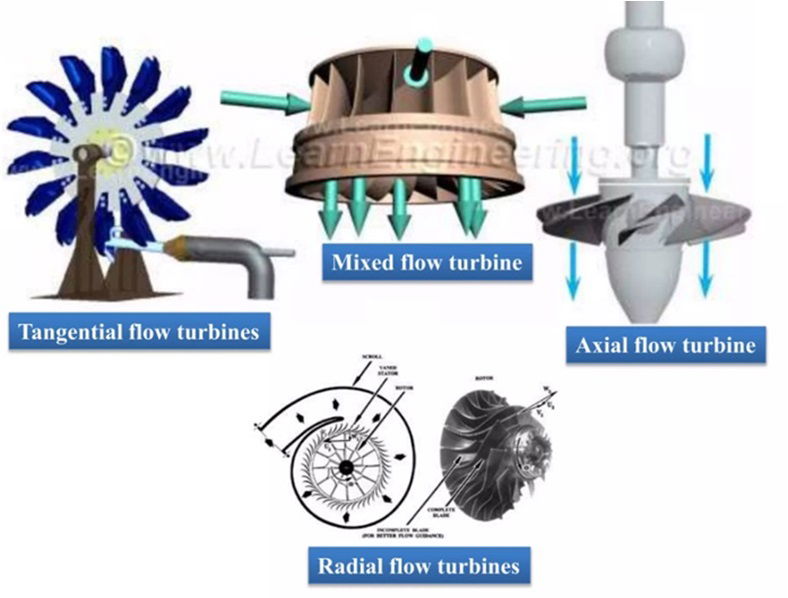
Hydro turbines are essential components in the generation of hydroelectric power, converting the energy of flowing or falling water into mechanical energy, which is then transformed into electrical energy. In this article, we will explore the fundamentals of hydro turbines, their classification, design parameters, and the advantages and disadvantages of using them for power generation.
What is a Hydro Turbine?
A hydro turbine is a mechanical device that harnesses the hydraulic energy of water—whether kinetic, potential, or both—and converts it into mechanical energy. This mechanical energy is then used to drive generators, producing electricity. The key components of a hydro turbine include:
- Runner: The rotating part of the turbine that converts water energy into mechanical energy.
- Control Mechanism (Gates/Nozzle): Regulates the flow of water to control the power output.
- Draft Tube: A conduit that helps recover kinetic energy from the water exiting the turbine.
Governing Equations of Power
The power generated by a hydro turbine can be understood through three main equations:
- Hydraulic Power:
Power = Flow Rate × Pressure - Mechanical Power:
Power = Rotational Speed × Torque - Electrical Power:
Power = Voltage × Current
Since the frequency of the electrical grid must remain constant, the rotational speed of the turbine is also constant when synchronized with the grid. Additionally, changes in voltage and head (water pressure) are relatively small, so they can be considered constant. Therefore, hydraulic power is primarily controlled by adjusting the gates or nozzles, which in turn regulate the torque and increase the generator current.
Classification of Hydro Turbines
Hydro turbines can be classified based on several factors, including power scale, head, flow pattern, energy transformation, orientation, construction, and regulation type. Below are some common classifications:
1. Power/Scale:
- Small (<50 MW)
- Mini (<1 MW)
- Micro (<100 KW)
- Pico (<10 KW)
2. Head:
- High (>150 m)
- Medium (30 to 150 m)
- Low (30 to 10 m)
- Very Low (<10 m)
3. Energy Transformation:
Impulse Turbines: Convert kinetic energy of water into mechanical energy (e.g., Pelton turbine).
Reaction Turbines: Convert both kinetic and potential energy of water into mechanical energy (e.g., Francis and Kaplan turbines).
4. Orientation:
Horizontal
Vertical
5. Flow Pattern:
Axial Flow
Radial Flow
Mixed Flow
Tangential Flow
Cross Flow
6. Specific Speed:
Pelton Turbine: 8-30
Francis Turbine: 50-250
Kaplan Turbine: 250-850
Specific speed is defined as the speed of a geometrically similar turbine that produces unit power under a unit head. It is a crucial parameter in turbine design and selection.
Advantages and Disadvantages of Hydro Turbines
Advantages:
Clean and Renewable Energy: Hydro turbines generate electricity without emitting greenhouse gases.
Robust and Sturdy: They are durable and can operate for decades with minimal maintenance.
Low Operation & Maintenance Costs: Once installed, hydro turbines have relatively low ongoing costs.
High Efficiency: Hydro turbines are highly efficient in converting water energy into electricity.
Energy Security: Hydroelectric power contributes to energy independence and security.
Wide Range of Operation: They can operate efficiently across a wide range of water flows and heads.
Disadvantages:
High Capital Cost: The initial investment for hydroelectric plants can be significant.
Environmental and Social Issues: Dams and turbines can disrupt local ecosystems and communities.
Fish Migration: Hydro turbines can interfere with fish migration patterns.
Site-Specific Design: Each hydroelectric project requires a customized design based on the site's characteristics.
Basic Design Parameters
When designing a hydro turbine, several key parameters must be considered:
1. Head:
Gross Head: The difference in water level between the reservoir and the tailwater.
Net Head: Gross head minus head losses due to friction, bends, and other factors.
Head Losses: Friction, bends, trash racks, etc.
2. Flow Rate:
Design Discharge: The flow rate corresponding to the turbine's maximum efficiency.
Rated Discharge: The flow rate corresponding to the turbine's rated power.
Maximum Discharge: The highest flow rate the turbine can handle.
3. Speed:
Synchronous Speed: The speed at which the turbine operates when synchronized with the grid.
Runaway Speed: The maximum speed the turbine can reach if the generator is disconnected from the grid.
- 4. Draft Tube Size:
- The draft tube must be properly sized to recover kinetic energy and prevent cavitation.
5. Turbine Regulation Characteristics:
Speed Rise: How quickly the turbine's speed increases under load changes.
Pressure Transients: Changes in water pressure during operation.
Fast/Slow Closing Rates: The speed at which the turbine's gates or nozzles can close.
Functional Guarantees in Turbine Bidding
When evaluating bids for hydro turbines, it is essential to compare not only the price but also the efficiency of the turbines. To ensure a fair comparison, bid prices are adjusted based on the turbine's efficiency over its entire operational range. This adjusted price is used to determine the most advantageous bid.
The efficiency of the turbine is measured at various points during its operation, with higher weights assigned to the points where the turbine is expected to operate most frequently. The successful bidder's efficiency becomes a contractual guarantee, and failure to meet this guarantee can result in penalties, such as liquidity damages or contract termination.
Conclusion
Hydro turbines play a vital role in harnessing the power of water to generate clean, renewable energy. Understanding the basics of how they work, their classification, and the key design parameters is essential for anyone involved in hydroelectric power generation. While hydro turbines offer numerous advantages, such as high efficiency and low operational costs, they also come with challenges, including high capital costs and environmental concerns. By carefully considering these factors, we can continue to develop sustainable hydroelectric power solutions for the future.